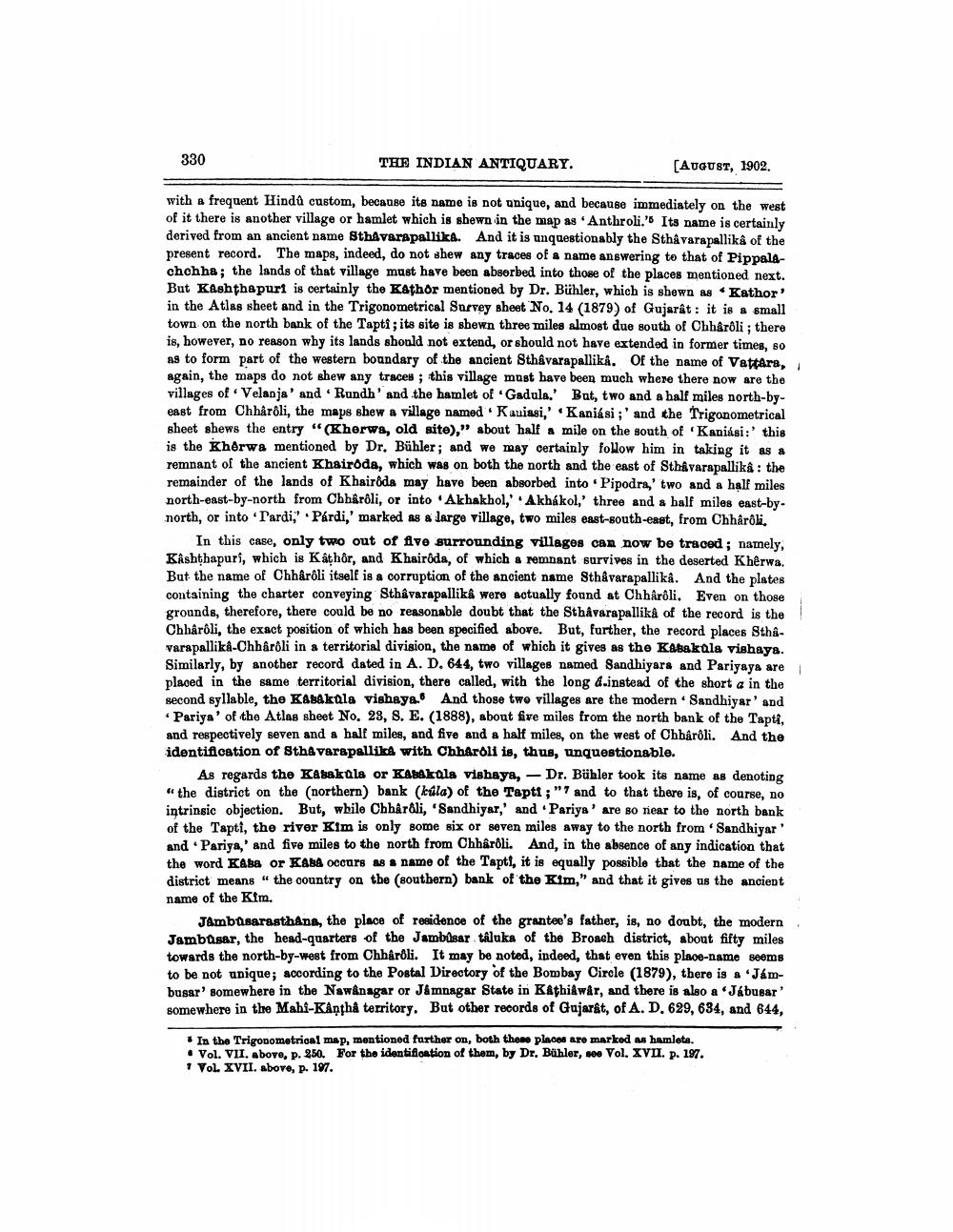________________
330
THE INDIAN ANTIQUARY.
[AUGUST, 1902.
with a frequent Hindù custom, because its name is not unique, and because immediately on the west of it there is another village or hamlet which is shewn in the map as Anthroli.' Its name is certainly derived from an ancient name Sthavarapallik. And it is unquestionably the Sthavarapallika of the present record. The maps, indeed, do not shew any traces of a name answering to that of Pippalachchha; the lands of that village must have been absorbed into those of the places mentioned next. But KAshthapuri is certainly the Kathor mentioned by Dr. Bühler, which is shewn as Kathor' in the Atlas sheet and in the Trigonometrical Survey sheet No. 14 (1879) of Gujarat : it is a small town on the north bank of the Tapti; its site is shewn three miles almost due south of Chhârôli ; there is, however, no reason why its lands should not extend, or should not have extended in former times, so as to form part of the western boundary of the ancient Sthavarapallika. Of the name of Vattara, again, the maps do not shew any traces ; this village must have been much where there now are the villages of Velanja' and Rundh' and the hamlet of Gadula.' But, two and a half miles north-byeast from Chhårðli, the maps shew a village named Kauiasi,' . Kaniási ;' and the Trigonometrical sheet shews the entry "(Khorwa, old site),” about half a mile on the south of Kanissi:' this is the Khorwa mentioned by Dr. Bühler; and we may certainly follow him in taking it as a remnant of the ancient Khairoda, which was on both the north and the east of Sthavarapallika : the remainder of the lands of Khairôda may have been absorbed into • Pipodrs,' two and a half miles north-east-by-north from Chhäróli, or into Akhakhol,'. Akhákol,' three and a half miles east-bynorth, or into 'lardi,' . Párdi,' marked as a large village, two miles east-south-east, from Chhåroli.
In this case, only two out of five surrounding villages can now be traced ; namely, Kishthapuri, which is Kathôr, and Khairôda, of which a remnant survives in the deserted Khêrwa. But the name of Chhåroli itself is a corruption of the ancient name Sthåvarapallikå. And the plates containing the charter conveying Sthâvarapallikê were actually found at Chhåróli. Even on those grounds, therefore, there could be no reasonable doubt that the Sthåvarapallikå of the record is the Ohhåroli, the exact position of which has been specified above. But, further, the record places Sthivarapallika-Chhârôli in a territorial division, the name of which it gives as the Kabakula vishaya. Similarly, by another record dated in A. D. 644, two villages named Sandhiyara and Pariyaya are placed in the same territorial division, there called, with the long d.instead of the short a in the second syllable, the Kasakula vishaya. And those two villages are the modern . Sandhiyar' and • Pariya' of the Atlas sheet No. 28, S. E. (1888), about five miles from the north bank of the Tapti, and respectively seven and a half miles, and five and a half miles, on the west of Chbârôli. And the identification of SthavarapallikA with Chhåroli is, thus, unquestionable.
As regards the Kalakala or Kabakals vishaya, - Dr. Bühler took its name as denoting “the district on the northern) bank (kula) of the Tapti ;"7 and to that there is, of course, no intrinsic objection. But, while Chbárali, 'Sandhiyar,' and . Pariya' are so near to the north bank of the Tapti, the river Kim is only some six or seven miles away to the north from Sandhiyar and Pariya,' and five miles to the north from Chhâróli. And, in the absence of any indication that the word Kaba or Kalle occurs as a name of the Tapti, it is equally possible that the name of the district means " the country on the southern) bank of the Kim," and that it gives us the ancient name of the Kim.
JAmbasarasthana, the place of residence of the grantee's father, is, no doubt, the modern Jambosar, the head-quarters of the Jambusar taluks of the Broach district, about fifty miles towards the north-by-west from Chharoli. It may be noted, indeed, that even this plaos-namo seems to be not unique; according to the Postal Directory of the Bombay Circle (1879), there is a Jámbusar' somewhere in the Nawanagar or Jamnagar State in Kathiawar, and there is also a .Jkbusar' somewhere in the Mahi-Kanthå territory. But other records of Gujarat, of A. D. 629, 634, and 644,
. In the Trigonometrical map, mentioned further on, both these places are marked as hamleta. • Vol. VII. above, p. 250. For the identifiontion of them, by Dr. Bühler, 100 Vol. XVII. p. 197. 1 VOL XVII. above, p. 197.




